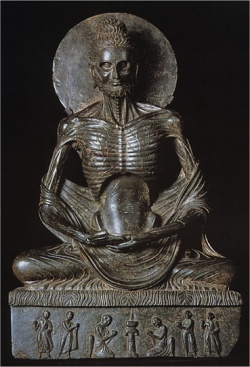The Pacceka-Buddha and the Pratyekayana
The Paccekabuddha or Solitary Buddha is one of the Three Types of Buddhas in Theravada. They only appear in times when there is no active Buddha-Sasana (Dharma Dispensation ). They resemble Samma Sambuddhas in that they discover the Dhamma and eventually attain Nibbana without the benefit of Dhamma Instruction. However, the do not make any vow to save others nor do they receive a prediction. Moreover, they do not leave behind any Dhamma teachings for others. My understanding is that since Pacceka-Buddhas have attained Nibbana; they are considered Arahants in the general sense.
Pacceka-Buddhas who lived before Shakyamuni’s Buddha-Sasana are mentioned in the Isigli Sutta:
In the past, monks, five hundred paccekabuddhas[1] lived for a long time on this Isigili mountain. As they were entering the mountain they were visible, but once they have entered, they were invisible. People seeing this remarked: ‘This mountain swallows these seers (isigilati)’; hence the name Isigili came into being.
“I will tell you, monks, the names of the paccekabuddhas. I will reveal, monks, the names of the paccekabuddhas. Listen, pay close attention, I will speak.” ~~ The Isigli Sutta
The Reseve Fund / Treasure Store Sutta mentions Paccekabodhi:
The Cula-Niddesa attributes the verses of the Rhinoceros Sutta to the Paccekabuddhas of the past. The Niddesa is a commentary attributed to Sariputra.
With persistence aroused for the highest goal’s attainment, with mind un-smeared, not lazy in action, firm in effort, with steadfastness & strength arisen, wander alone like a rhinoceros. ~~ Rhinoceros Sutta
For a detailed study, see: The Paccekabuddha: A Buddhist Ascetic by Ria Kloppenborg
The Early Mahayanists inferred that there had been, and is, a Pratyekayana, or Solitude Vehicle, taught by the Buddha, to attain Solitary Awakening (Pratyekabodhi). Some of the Mahayana Sutras and later commentaries mention teachings for Pratyekas.
I suspect the early, original Mahayanists still held to the traditional idea that Pratyeka-buddhas only appear when there is no extant Dharma Dispensation (Buddha Sasana), such as between Samyak Sambuddhas. So they likely saw the Pratyekayana as a gate or path that was closed during this Buddha Sasana of Shakyamuni.
At any rate, the early Mahayanists certainly saw Pratyeka-bodhi as inferior to Samyak Sambodhi. I would guess they saw Pratyekabodhi and Shravakabodhi as qualitatively identical; as the attainment of Nirvana, as arhatship.
As with the Samma Sambuddha, the Suttas should have teachings about them, but maybe none for them? However, there are the verses allegedly uttered by Pratyekabuddhas from the past. Also, some of the traditions maintain that Pratyekas awaken via direct observation of Pratityasamutpada (dependent origination. dependent arising. interdependent co-arising, conditioned arising, conditioned genesis). The Buddha taught paticca-samuppada,
see: the Paticca-samuppada-vibhanga Sutta. Also paticca-samuppada .
Moreover, I have the impression that some schools of later Mahayana might view the Pratyeka Vehicle as still accessible for some, and even see Pratyeka-bodhi as possibly a slightly higher level of awakening than Shravaka-bodhi? I have speculated for decades that teachings for a private vehicle would be, well, private. Perhaps this is the source for esoteric teachings? Just as Mahayana started as the Bodhisattvayana, could the Vajrayana have started as the Pratyekayana? The last time I publicly suggested that, I was swiftly shot down.

